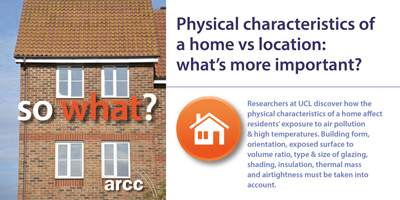Researchers at UCL have found that the physical characteristics of an individual home may be more important for indoor environmental quality than its location within a city.
Buildings function as modifiers of climate. How a building modifies occupant exposure to temperature and pollution depends largely on its physical characteristics. This means that for a given outdoor temperature and pollutant concentration, indoor temperatures and pollutant concentrations will vary across the housing stock. Factors that influence indoor environmental quality include: building form, orientation, exposed surface to volume ratio, types and size of glazing areas, shading, thermal insulation, thermal mass and airtightness.
Relevance
Climate change will increase the risk of overheating in buildings in the UK. The phenomenon will be greater in cities, where outdoor temperatures are already higher compared to their rural surroundings due to the urban heat island effect.
To combat climate change and reduce carbon emissions from the building sector, energy efficiency building standards will become increasingly stringent. However, increasing the thermal insulation and airtightness levels of building envelopes may have unintended consequences for indoor air quality and summer thermal comfort.
Although the location of a building is important for indoor temperatures and pollution (e.g. location within an urban heat island or proximity to a major road), the levels of protection offered by its building fabric also need to be considered.
Findings
- Indoor overheating is determined more by the characteristics of a dwelling than its location within a city.
- Homes most prone to overheating are top-floor flats, buildings with only one external façade, no shading, very high or very low insulation levels.
- Internal wall insulation may increase indoor temperatures if the property is not sufficiently ventilated.
- Detached and semi-detached dwellings are the most vulnerable to high levels of infiltration of outdoor air pollution.
Now what?
Well-designed buildings can offer high levels of indoor environmental quality even if located in very warm or polluted urban areas.
Careful consideration of options for individual building components needs to be made when designing energy efficiency retrofit strategies in order to minimise the risk of indoor overheating and poor indoor air quality in the future.
Existing homes in the UK were designed with a different climate in mind and are, therefore, optimised to maximise solar gain. In addition, our buildings need to become more energy efficient if carbon emission reduction targets are to be met. However, the impacts on indoor overheating and air quality should not be neglected. ‘Win-win’ retrofit options that combine both climate change mitigation and adaptation should be identified and implemented.
Residents
Provide sufficient ventilation, especially if you live in a highly insulated or airtight home.
Homeowners / landlords
Carefully consider the impact of retrofit solutions on indoor environmental quality.
Policymakers / urban planners
Policies to protect against the adverse effects of high summer temperatures in cities may need to prioritise dwelling design and construction over improving external conditions in the urban heat island.
Architects / retrofit providers
- When designing new homes, incorporate passive cooling strategies and indoor air quality strategies (geometry, orientation, ventilation pathways etc.) in the design from an early stage and not as an afterthought.
- When retrofitting existing homes, consider the physical characteristics (orientation, thermal mass, etc.) and occupancy patterns of individual buildings and avoid ‘one-size-fits-all’ solutions.
- When specifying insulation options and positioning, consider the whole year performance of the dwelling and not only winter space heating needs and carbon reduction targets.


